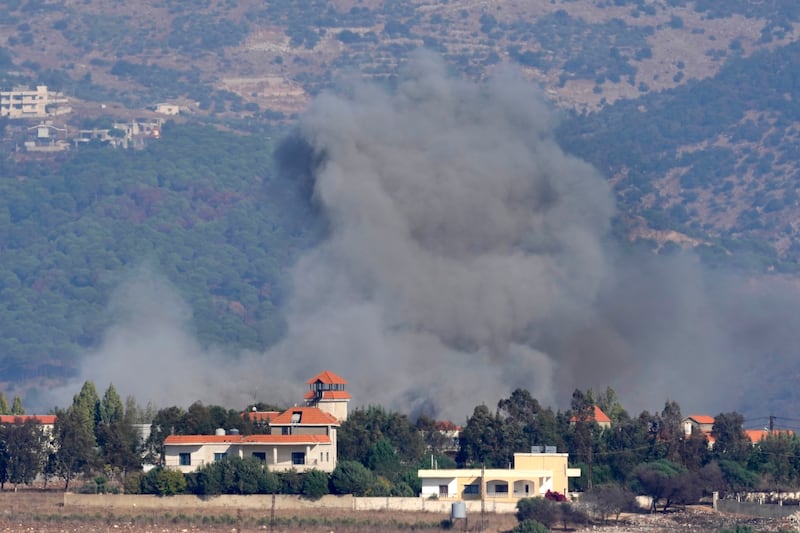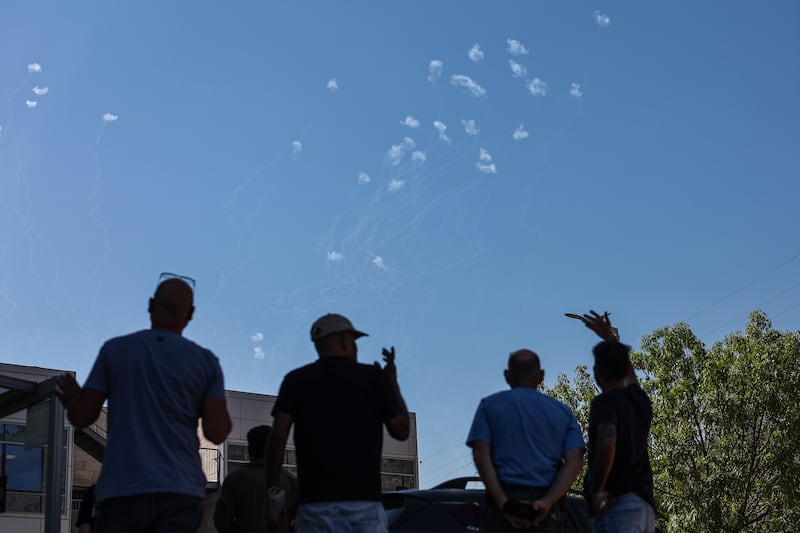In 2006, the last time Israel and Hizbullah went to war, the Israeli air force ran out of pre-vetted targets within the first week.
For the rest of the 34-day war, Israeli pilots flew the world’s best warplanes but only struck Hizbullah positions exposed by the fighting, rather than strategic sites revealed by years of deep intelligence and careful research.
That war ended in what was, at best, a stalemate between Israel, the region’s best resourced military, and Hizbullah, the Iran-backed militant group that has only grown stronger over the past 18 years.
Now, as large-scale Israeli air strikes in Lebanon push the bitter foes to the verge of another full-scale war, the military lessons learned – or not learned – by both sides from 2006 could reshape the region, and determine if victory can be had for either side.
“The most important lesson we learned from 2006 was to teach ourselves – which is almost impossible – to be more modest,” said Ehud Olmert, Israel’s prime minister during the 2006 war. “A full-on conflict with Hizbullah, which could expand to a full-on conflict with Iran, is going to be very painful, very bloody,” he warned.

The lack of a conclusive victory in 2006 haunted Olmert’s premiership. In the years that followed, the Israeli military studied its failures and drew other lessons from its intermittent wars against Hamas. The result is what Aviv Kochavi, previous chief of staff of the Israel Defense Forces, described in 2020 as the “victory doctrine”.
At its heart lies a bank of thousands of vetted targets, according to several Israeli military officials, compared with the dozens at hand at the start of the 2006 war.
Built out with intelligence gleaned during small rounds of fighting with Hizbullah, dubbed by the IDF as “wars between wars”, Israel’s military intelligence continuously add and update targets to this vault, using satellites, drones and human intelligence from across the region.
The result, according to Shlomo Mofaz, former head of the counterterrorism arena at IDF intelligence, is a densely populated “intelligence picture” of Hizbullah’s assets, from missile sites to command structures.
On Monday, as the Israeli air force started pounding Lebanon, its “victory doctrine” was on full display with dozens of warplanes and drones flying simultaneous sorties that hit 1,600 targets, striking fear and panic across Lebanon in the country’s deadliest day in decades. Firas Abiad, Lebanon’s health minister, said the bombing raid hit medical centres, ambulances, and fleeing civilians in a wave of “carnage”.

Israel’s bombardment, which it said was focused on weapon depots and other Hizbullah infrastructure, formed what was the second phase of a sequenced plan.
The first phase, Mofaz said, took aim at Hizbullah’s leadership, including the July 30th killing of Fuad Shukr, its highest-ranking commander, and last week’s elimination of a clutch of senior figures in the elite Radwan unit during a clandestine meeting in Beirut.
“You can already see from the targeted killings in the past few weeks the quality of the intelligence,” Mofaz said. Last week’s synchronised detonation of thousands of Hizbullah pagers also killed 37 in an attack carried out by Israel, according to people briefed on the operation.
The ultimate goal of the current Lebanon campaign, according to Israel’s premier Binyamin Netanyahu, is to degrade Hizbullah and force it to pull back its elite Radwan units far from Israel’s northern border.
Israeli strikes killed more than 550 people since Monday, and wounded in excess of 2,000
But for that to succeed so must the “victory doctrine,” which seeks to destroy Hizbullah’s capabilities quickly before international outrage over civilian casualties forces Israel to stop. Israeli strikes killed more than 550 people since Monday, and wounded in excess of 2,000.
“Essentially, we are targeting combat infrastructure that Hizbullah has been building for the past 20 years,” IDF chief Herzi Halevi said after the first full day of bombardment. “This is significant – we are ... preparing for the next phase.”
How Israel’s campaign continues depends to a large extent on Netanyahu’s political calculations – western diplomats point out that a diplomatic alternative to this campaign has existed for months. Hizbullah has said it would back off from its cross-border assaults if Israel agreed a ceasefire with Hamas in Gaza.
It also depends on Netanyahu’s definition of “total victory”. In Gaza, where Hamas still holds more than 100 hostages and refuses to surrender, it has entailed a year of war, resulting in 41,000 deaths, according to Palestinian health officials – but no sign of a victorious exit.
“[While] they’ve obviously failed to ‘destroy’ Hamas, they’ve done a huge amount of damage to their military capability,” said Sir John Sawers, who headed the UK’s foreign intelligence service MI6 until 2014. “If they could do something even vaguely comparable with Hizbullah, I think they’ll feel they’ve secured themselves for a few years to come.”
For now, Netanyahu has said the Lebanon campaign, which the IDF has named Operation Northern Arrows, is limited to making northern Israel safe enough for 60,000 displaced citizens to return to their homes, a year after Hizbullah started shelling the border region in solidarity with Hamas.
To do that, the Israeli military will need to achieve two main objectives, analysts said: reduce Hizbullah’s estimated arsenal of as many as 200,000 rockets and short range ballistic missiles; and push Hizbullah’s fighters north of the Litani river.
The first involves the air campaign already under way. The 1,600 targets hit by Israel on Monday were, by any measure, vast in scale. The intensity was double that in the first two days of Israel’s bombing campaign in Gaza last year, and almost four times the average daily rate of 428 targets hit in Gaza over the next five weeks, according to official figures.
It is also eight times the average 200 targets a day hit during the 2006 Lebanon war, when as many 70 Israeli aircraft operated at different altitudes – from Blackhawk helicopters near the ground, to Gulfstream G550 surveillance aircraft at high altitudes.
“For the Israelis, most of the military thinking after 2006 was ... to emphasise the air campaign as a way to disrupt quickly and decisively Hizbullah’s capabilities and leadership,” said Jean-Loup Samaan of the National University of Singapore’s Middle East Institute. “Hizbullah’s ... air defence is very limited and inefficient against the Israeli air strikes.”

Hizbullah has also drawn lessons from the 2006 war. It has imported Iranian missile and drone technology, trained up its cadres, and bored a network of tunnels thought to be larger than Hamas’s in Gaza. Although dug through soft sandstone, Hamas’s “metro” has proven hard to destroy, impervious to Israeli electronic surveillance, and an effective refuge for fighters and their weapons.
In addition, over the past year Hizbullah has mapped out potential Israeli targets and studied how Israel responds to its drone attacks, including several that slipped past air defences.
“They learned, and also we have learned,” said Mofaz, who now heads Israel’s Intelligence and Terrorism Information Center.
On Wednesday, Hizbullah said it fired a Qader 1 ballistic missile targeting the headquarters of Israel’s Mossad intelligence agency in Tel Aviv, Israel’s economic capital. The Israeli military said a surface-to-surface missile was intercepted by air defence systems. It said this was the first time Hizbullah had fired one of its rockets this deep into Israel, and claimed that the group was aimed a civilian targets.
A recent study by Reichman University warned that Hizbullah could fire as many as 3,000 rockets and missiles a day, with dense barrages designed to overwhelm Israeli air defences by focusing on single targets, from military bases to cities.
“The next few days are crucial,” said Mohanad Hage Ali, deputy director of research at the Carnegie Center in Beirut. If Hizbullah accepts a ceasefire with Israel without there being one in Gaza, “all the deaths so far will have been for nothing,” he said. “But if the organisation can show that it can still strike back with force, it could make a huge difference ... It would help restore morale and sustain the fight.”
It would also prompt another round of Israeli escalation, according to several Israeli officials familiar with the IDF’s plans.

A Hizbullah missile strike on central Israel would see the IDF retaliating by hitting a wider range of targets in the militant group’s stronghold in south Beirut, escalating from targeted killings to significant air strikes, said one official who asked not to be named.
In comparison to the air campaign, any subsequent land offensive would be far more complex and dangerous. The Israeli invasion of Lebanon in 1982, which aimed to establish a similar northern “security zone”, is still viewed as the country’s Vietnam. Furthermore, the Israeli army today is tired after a year of fighting Gaza.
[ Q&A: What is Hizbullah's position and influence in Lebanon?Opens in new window ]
Mofaz described a ground operation as “the last stage”, and cautioned that it would not give Israel a big advantage. He pointed out that Israel has not called up reserves, and currently has only three divisions in the north – the same number as it deployed during the failed 2006 Lebanon war, and less than the four divisions that fought in Gaza. He reckons a ground attack is “not on the table for the next few days or even weeks”.
But it may yet come. If it does, the ex-premier Olmert said there was no doubt who would ultimately win – and the cost to both sides.
“At the end of the day Israel will survive and Hizbullah may suffer such a devastation that will destroy them, and leave large parts of Lebanon in rubble. But Israel will suffer a great deal also,” he said. “It will be the likes of which we have never suffered in all our wars with neighbours since 1948.”
– Copyright The Financial Times Limited 2024
– Additional reporting: AP
- Sign up for push alerts and have the best news, analysis and comment delivered directly to your phone
- Find The Irish Times on WhatsApp and stay up to date
- Our In The News podcast is now published daily – Find the latest episode here






















